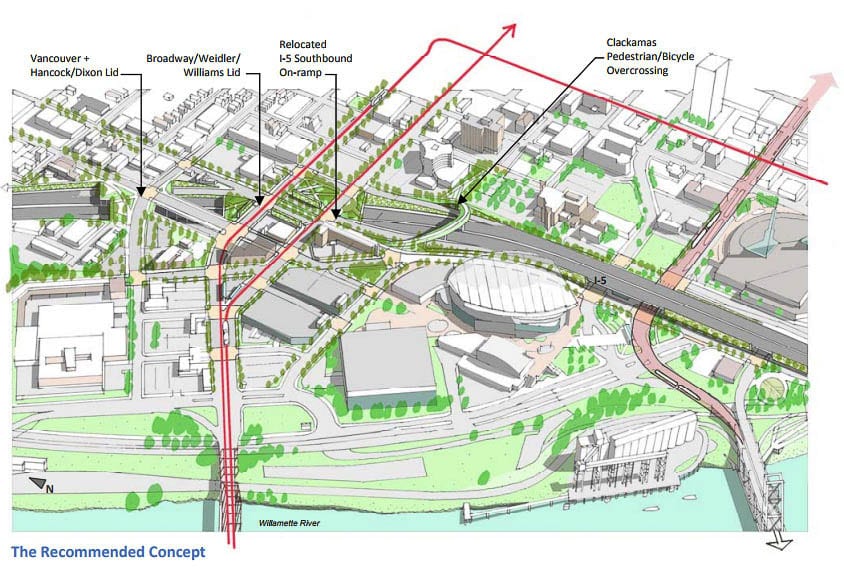$795 million project may have two highway covers
The Executive Steering Committee that will oversee the $795 million Interstate 5 Rose Quarter project met earlier this week. The project will extend “auxiliary lanes” on I-5 between I-84 and I-405, and build two “lids” over the top of I-5. The project cost was originally $450 million, as passed in Oregon HB 2017, but now has a price tag of $795 million.
The committee’s work is of importance to Clark County citizens because the traffic congestion commuters experience while commuting on I-5 is severely impacted by the bottleneck at the Rose Quarter. Additionally, it’s likely money from tolling I-5 will be used to pay for an unknown portion of the improvements at the Rose Quarter, and the more than 70,000 Clark County residents commuting to Oregon (pre-COVID numbers) and would pay those tolls.
The Oregon Department of Transportation has chosen to do a “first in the nation” equity committee to involve the minority community in the project. Monday’s meeting of the Executive Steering Committee (ESC) discussed the “highway covers” or “lids” that will be constructed over the top of I-5. The focus was that these highway covers will help to heal the divisions in north Portland’s minority community the construction of I-5 caused 60 years ago.
“I always think that it’s important that we are acknowledging the history of our project area, and the harm to communities of color, specifically the black community and albino both past and present, that resulted from construction of I-5, and I think in acknowledging this history,” stated one of the moderators. “As we begin to design and future build this project with you is the executive steering committee of which the community we must work together to make sure that our efforts moving forward don’t exacerbater or repeat the harms of the past.”

The committee members hope to resolve some of these issues with their Disadvantaged Business Enterprise (DBE) and workforce program. It is hoped DBE will get 18 to 22 percent of the project.
Earlier this summer Albina Vision Trust withdrew their support for the project. The Portland City Council withdrew their support as well..City Commissioner Chloe Eudaly, who oversees the Portland Bureau of Transportation, which would be a key partner in the I-5 widening, issued her most scathing criticism of the project to date.
“It became clear to me that ODOT was determined to move forward with the project as planned, that they were resistant to congestion pricing, that the steering committee was to be treated as an advisory body with no governing authority, that ODOT did not seem to grasp the concept of restorative justice, and we were unlikely to achieve the outcomes we were seeking,” Eudaly said.
There was discussion over the impact the project will have on Harriet Tubman Middle School. Julia Brim-Edwards expressed concerns that air quality issues related to the health of the children at the school and a nearby park associated with the school are being ignored.
It was mentioned that the school district has already spent over $20 million in a state of the art air filtering system to improve indoor air quality inside the school. The school is adjacent to I-5.
There is a Highway Cover Coordinating Committee (H3C) being created to provide input to the Executive Steering Committee on the two covers or “lids”. These are scheduled to be built over I-5 as one piece of the community redevelopment part of the project.
The committee was shown several examples of highway covers from around the nation. “We heard the question, what exactly do you mean when you say highway covers and what might they entail?” stated a staff member. The ESC was shown several examples of covers from around the nation.
Klyde Warren Park in Dallas, Texas is 5.2 acres over a freeway connecting the arts district in their downtown. It has one small building containing a restaurant and a performance stage. The rest of it is a park with five water features and an open Great Lawn for gathering and public assembly.
Next was a project in Boston, Massachusetts called Fenway Center, with buildings over its lid. The project involves the 99-year lease of air rights and will build a 90,000-square-foot deck over the freeway. The highway cover will support a billion dollar two tower complex containing office and lab space for life science companies, according to the staffer.

The ESC was shown Hance Park highway cover which goes over Interstate 10 in Phoenix. The Presidio Parkway project in San Francisco is a one-and-a-half mile section of Highway which carries 100,000 vehicles a day. The project connects the Presidio with the Golden Gate Bridge.
Metro President Lynn Peterson asked that other projects be shown to the ESC at their next meeting or via email.
After seeing the diversity of projects, Marlon Holmes representing N/NE Housing Strategy asked what is the area that is being proposed for the Rose Quarter highway covers. He opined “5 or six miles?” The staff responded by sharing the entire project was from I-84 to I-405 at the Fremont Bridge. The covers would be a small part of the entire project — the Broadway-Weidler area and where Williams and Vancouver Avenues cross I-5.
Holmes advocated for more discussion on what’s being proposed for the covers. “Are we really talking about housing projects or mixed use or commercial development? Are we talking about all office space? There’s a lot of things our city in particular is wrestling with right now; and it all starts and stops with housing and jobs,” said Holmes.
ESC Chair Alando Simpson closed the meeting with a reminder. He asked the group to look beyond the photographs and that they research the funding mechanisms and models that come with these projects. “These things can get really expensive really quick,” he said.
The committee will continue its discussions and deliberations next month.




